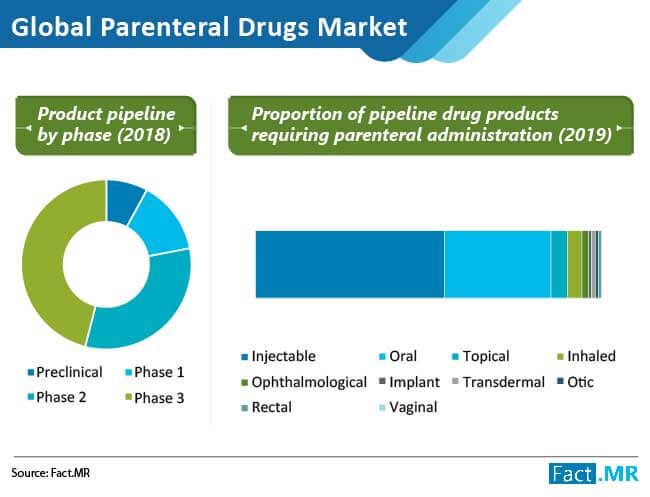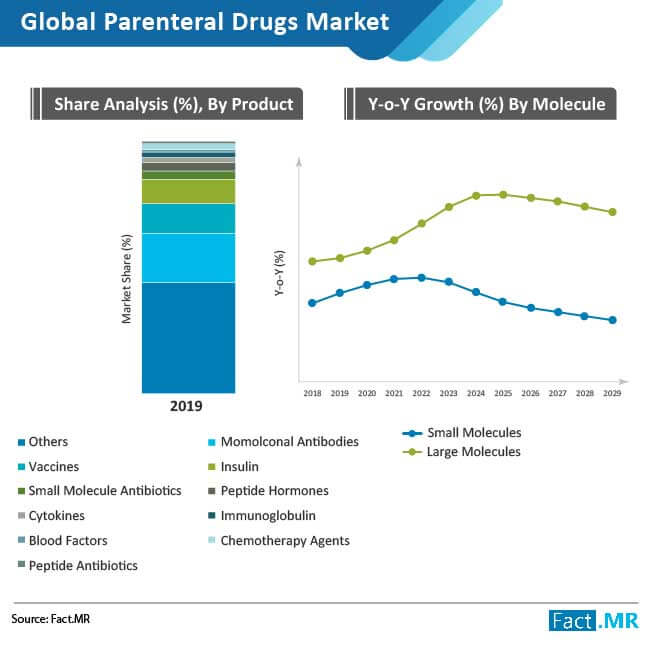Parenteral Drug Market
Parenteral Drugs Market By Product Type (Monoclonal Antibodies, Immunoglobulin, Cytokines, Insulin, Peptide Hormones, Blood Factors, Peptide Antibiotics), By Application (Oncology, Infectious Diseases, Diabetes, Blood disorders & Others), By Region- Global Market Insights 2019 -2029
Analysis of Parenteral Drug market covering 30 + countries including analysis of US, Canada, UK, Germany, France, Nordics, GCC countries, Japan, Korea and many more
Parenteral Drugs Market gains Traction, Driven by Automation in Drug Production and Inclination towards Single-use Equipment
Many parenteral drug manufacturers are adopting a single-use strategy for antibodies, proteins, cell therapy, vaccines, and gene therapy. FDA recommends the use of automation in pharmaceutical manufacturing.
While continuous manufacturing offers both time and cost benefits; automated production reduces labour cost. However, for biologics and other advanced products, a cost-efficient and automated technology is yet to be developed.
Furthermore, parenteral drug manufactures are currently focused on maintaining high quality of their products. Single-use technology maintains the quality of biologic parenteral drugs. Additionally, manufacturers are making efforts to incorporate Quality by Design (QbD) in their processes.
On this premise, the parenteral drugs market is poised to reach a staggering valuation of US $ 802Bn by the end of the forecast period (2019-2029)
Don't Need a Global Report?
save 40%! on Country & Region specific reports
Increased Spending on Biologic Drugs to Shape Parenteral Drugs Market
There were nearly 500 parenteral drugs in the pipeline as of 2018. Increase in R&D spending in the pharmaceutical industry offers an opportunity for large molecule drugs to enter the pipeline.

Oncology continues to remain the key research focus owing to the large patient pool that offers significant growth opportunities once the drug is launched in the market.
The proportion of drugs in the pipeline requiring parenteral administration rose by ~2%, from 2018 to 2019. This is primarily due to the rise in the number of biologic drugs in the market. Most biologic drugs are available in injectable form, thus increasing the number of parenteral drugs in the pipeline, thereby driving the growth of the parenteral drugs market.
More Insights, Lesser Cost (-50% off)
Insights on import/export production,
pricing analysis, and more – Only @ Fact.MR
Monoclonal Antibodies in the Forefront, Large Molecule Parenteral Drugs Gaining Traction
In terms of share analysis by product, monoclonal antibodies (mAb) led the global market, contributing a revenue share of 20% in 2018.
Revenue shares from monoclonal antibodies product type segment are foreseen to increase primarily due to the expanding product pipeline and high number of product approvals by the FDA.
The segment of large molecules parenteral drugs will see an upward year on year growth trajectory as is seen in the figure below with growth steadying out after mid-term forecast
Large molecule drugs are biological injectable preparations which are administered to treat chronic disease like cancer, diabetes and blood diseases. Large molecules segment is a key focus area of the pharmaceutical industry at present. This is due to the highly biocompatible nature of large molecules. Approval for large molecules and biosimilars is a long and lengthy process that requires a significantly high investment for research.

Big Pharmas Eyeing Untapped Markets for Stronger Foothold
Big pharmaceutical companies are acquiring smaller firms in emerging markets in Asia Pacific for sustainable growth. In terms of distribution, hospital pharmacies accounted for the maximum revenue share on the back of increased hospitalization and availability of skilled manpower.
This was followed closely behind by retail pharmacies. Companies in the parenteral drugs market are focusing on geographical expansions and establishing their new facilities close to target markets. They are also consolidating their existing manufacturing capabilities to capture a larger market share.
Know thy Competitors
Competitive landscape highlights only certain players
Complete list available upon request
Key Segments of Parenteral Drugs Market
Fact.MR’s study on the parenteral drugs market offers information divided into six important segments— product type, application, molecule type, route of administration, distribution channel, and region.
This report offers comprehensive data and information about the important market dynamics and growth parameters associated with these categories.
| Product Type |
|
| Application |
|
| Molecule Type |
|
| Route of Administration |
|
| Distribution Channel |
|
| Region |
|
- FAQs -
Who Are The Major Participants Operating In The Global Parenteral Drug Market?
Key Participants Operating Are Merck & Co. Inc., Teva Pharmaceutical Industries Ltd., Sanofi S.A., Novartis AG, and Pfizer Inc.
Which Segment Is Dominating the Offerings in the Global Parenteral Drug Industry?
Oncology Segment Is Dominating The Global Parenteral Drug Industry